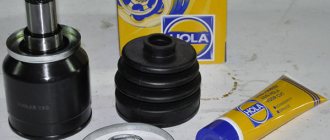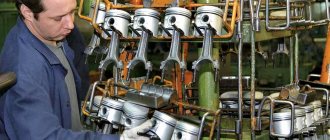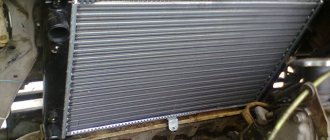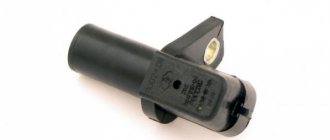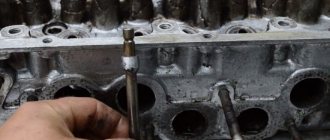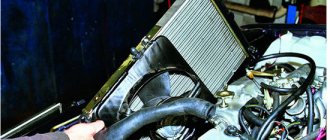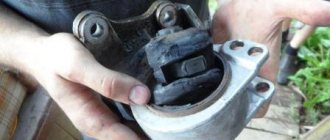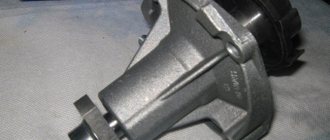The car body is constantly exposed to mechanical stress, and some parts of the body often experience chemical attack. Parts of the car body such as sills are subjected to this ordeal every day. These elements serve not only as decoration. They provide the body with additional rigidity and help withstand torsion loads and “break” loads.
In addition to the mechanical impact, thresholds are also negatively affected by reagents - salt, etc., which are used liberally on the road surface in winter. Due to the treatment of asphalt with chemicals, the thresholds are destroyed. Corrosion slowly but surely thins the metal from which these elements are made, and over time they turn into dust. It is the threshold that is most often subject to replacement, since it has a short service life. But where can you find a repairman or car service that will replace the thresholds of a VAZ 2112 car in Moscow with high quality and with guarantees?
What is this?
Re-welding of thresholds on a VAZ 2107 is understood as a service during which a car mechanic restores a worn-out trim by re-welding, straightening, and painting. Thresholds are highly susceptible to the influence of various negative factors: shock, contact with reagents, water, temperature changes. All this leads to the fact that the paintwork is damaged, and the metal begins to become covered with rust.
Thresholds perform a protective function: they prevent the formation of cracks, dents, and abrasions on the car fender.
You need to order this service in the following cases:
- The spare part is severely deformed.
- The part is covered with rust.
- There is a large amount of damage that cannot be repaired by pulling out the metal.
The damaged threshold can be replaced with a new one. But, as a rule, this is more expensive than overcooking.
Digestion is performed using special tools and equipment. The work is painstaking and troublesome. Therefore, it is better to order such a service from professionals. To do this you need to do a number of steps:
- Choose a suitable service station.
- Call the administrator and find out the approximate price of the work and terms of cooperation.
- Arrange to come to the master.
- Bring the car to a service station for repairs.
- Wait until the specialist finishes the work.
- Accept the restored threshold.
- Pay the auto mechanic.
Replacing a car threshold
What components can we offer to replace thresholds?
Given the great demand for these body parts, manufacturers are working quite actively to saturate the market. Even for the same car model, you can find several options that differ in price. But you should understand that the difference in quality can also be noticeable.
We are ready to assist in finding and delivering thresholds for various cars, and we offer you to use one of the following options:
- Original factory components - with this choice, you will receive body iron that exactly matches the threshold in size, metal thickness, and quality of anti-corrosion treatment. Most often, this option is chosen by the owners of quite expensive imported cars, the bodies of which usually have no special complaints. But for budget models and mid-priced ones, such a choice is not always justified.
- In this case, it is quite possible to pay attention to more affordable analogues , the production of which is carried out by many companies in Russia and Asia. If your car’s original sills began to rot in the first couple of years of operation, then it makes sense to pay attention to this particular segment. For any car that is assembled in Russian factories, it will not be difficult to find such spare parts.
- If you want to save money on repairing a foreign car, then you can order contract thresholds , although in this case you will have to wait a little longer. But the quality of the components is in no way inferior to the original. We work with suppliers who provide a guarantee and confirm compliance with documents.
It’s rare to find anything worthwhile at nearby showdowns. In most cases, the same rotten thresholds, so there is no particular point in searching in this direction. This option is only acceptable when an urgent replacement is needed. But at the same time, you should pay special attention to the condition of the hardware and you should not buy thresholds with shipping if there is no way to check their condition.
Possible difficulties when installing new thresholds
Replacing thresholds is a body repair of medium level of complexity. If you only need to install a new external part, then there are no special problems, other than the need for an exact fit. But when replacing with amplifiers, you will need to control the geometry of the body, which is almost impossible to do in a makeshift way. The best option is to have it replaced by a service center equipped with slipway equipment with a computer stand that allows you to check the geometry using factory control points.
Additional problems arise from the need to weld thin metal, which is easily deformed when overheated. Therefore, the main technology used is spot welding, with the help of which it is necessary to form a completely closed seam. In addition, it is necessary to use various welding methods - butt welding, overlap welding. And each of them requires different anti-corrosion protection and processing technology.
We also note the need to paint the thresholds after installation, and this must be done in a painting booth. Otherwise, it is almost impossible to achieve quality paintwork commensurate with the factory one.
And one more point that should not be overlooked - replacing thresholds requires a significant amount of preliminary reinforcement work. Assembly and disassembly can take up to 15–20% of the total time required for repairs.
What reinforcement work will be required?
It would seem that there is nothing to disassemble, especially in small city cars. Let's look at a simple example of replacing a threshold that has rotted along with the amplifiers. To dismantle the damaged element, you will need to release all the welds that connect it to the body, as well as remove, disassemble and remove other parts that limit access. This list includes:
- Front and rear doors, without dismantling which it will not be possible to cut out the threshold reinforcements without disturbing the geometry of the body.
- The front fender, under which part of the threshold extends in the area of connection with the pillar.
- To remove the wing, you need to dismantle the front optics, remove the bumper, fender lockers, disconnect the headlights and turn signals from the on-board network.
- On the interior side, it may be necessary to dismantle the pillar trim and remove the seats, which will not make it possible to crawl to the junction of the side panel with the floor reinforcements.
When replacing only the outer part of the thresholds, the list of reinforcement work is somewhat reduced; for example, you can leave the seats and pillar trim alone. But this will not eliminate the need to protect these areas from sparks when working with a grinder or welding machine. Therefore, it is still better not to save money or reduce the amount of disassembly. Only by creating comfortable conditions can you increase the speed of work, rather than spending hours on additional protection of the interior or trying to crawl to the weld from an awkward position.
Partial replacement of thresholds
The most typical type of repair that we have encountered. The main problem, of course, is severe rust, but often the metal is damaged as a result of unsuccessful parking or road accidents. In this case, it may be necessary to restore the geometry with alignment of the main threshold amplifier.
It should be given credit that the internal power part does not rot so actively; in most cases, living metal remains even on the top of the linings themselves. But in this case, you should not save money and cut out only the damaged areas. Rust will appear in welding areas quite quickly. Therefore, if you have already decided to replace it, install a new threshold completely, it will be more reliable. But in any case, before making a decision, you should carefully inspect the amplifier, if necessary, remove existing minor traces of rust, and re-carry out anti-corrosion treatment. There is no point in hiding red spots under a new lining, even if you are preparing the car for sale.
Dismantling damaged elements
The threshold is connected to the racks with a continuous seam, and standard spot welding is used along the flanges of the openings. Therefore, first of all, it is necessary to clean all these areas to the metal. In order not to make a mistake in the cutting lines along the racks, we try on the new threshold directly on the old part and mark the place where the future joint will be formed. We dismantle the threshold according to the following scheme:
- We cut the metal from the posts along the marked lines without damaging the internal amplifier.
- Along the doorways and in the lower part of the threshold, we drill out all the welding points that secure the outer trim to the parts of the power part of the sidewall.
- If this is not possible, then we simply cut off the metal, retreating about a centimeter from the seam. We will simply cut off the remaining strip in the future, destroying the welded points with a chisel.
- During factory assembly, all welds are sealed with sealant, so during dismantling you will have to make significant efforts to break the layer of this material. We work extremely carefully so as not to damage the amplifier.
There are no particular difficulties at this stage. If we are talking about replacing thresholds on both sides, then the work is carried out in parallel by two mechanics, this allows us to speed up the process somewhat.
Preparing the donor and body for installation
After dismantling, we align all the edges along which the threshold was welded, we clean these surfaces down to the metal, removing traces of welding and sealant residues. We inspect the elements of the load-bearing frame, if necessary, treat it with a rust converter or simply clean off the corrosion areas with a grinder or manually. To prevent the reappearance of saffron milk caps, we clean and degrease the metal, then cover it with 2-3 layers of epoxy-based primer. This coating has good strength characteristics and prevents the penetration of moisture into the iron, which provides protection against rust. Additionally, we spray all the internal hidden cavities with anti-corrosion compounds, the same Movil works quite well.
At the same stage, we check the geometry of the car body, especially if we are talking about replacing the threshold after an accident. Before trying on a new threshold, you need to make sure that all dimensions correspond to the values set by the manufacturer. Usually, the lengths and diagonals of the posts and openings, linear dimensions are checked with reference to the opposite side of the car, the rear and front parts of the body. If necessary, pull out the amplifiers, placing them in the required position.
New thresholds are usually supplied by the manufacturer with a coating of protective transport primer. You cannot paint over such a layer; any car enamel will come off within a few months. Therefore, we clean such a threshold down to the metal. Further processing, namely drilling holes for spot welding and priming, is best done after the threshold has been completely adjusted to its location.
Adjusting the threshold according to the rules
The correct shape of the outer surface of the body, the uniformity and size of the gaps between the threshold and the front fender and doors depend on this stage. In some cases, additional problems may arise due to inaccurate stamping of a new part; sometimes it is even necessary to trim, bend or straighten certain sections. But it is worth noting that such situations relate mainly to inexpensive analogues, for which such differences are not uncommon. Such problems do not arise with original components.
We install the new threshold in the standard position, check the tightness of the fit in the areas where spot welding is planned (doorways and the lower part). Only having achieved the required position, we begin to adjust the solid joints along the racks, in the front and rear parts of the threshold. We cut off the excess metal so that the gap does not exceed 1–1.5 mm, otherwise it will not be possible to form a high-quality closed seam.
We make a couple of weld points so that the threshold is held in place without the help of clamps and pliers, we hang the doors and try on the front fender. At this stage, we further adjust the position, achieving clear and uniform gaps between all involved body elements.
Upon completion of the adjustment, remove the threshold, drill holes for spot welding, process them, removing burrs. After degreasing, protect the inner surface with the same epoxy primer. The only caveat is that all areas along which welds will pass are treated with a special conductive primer with zinc. This composition burns less and does not interfere with the formation of a weld point with the required strength. We also cover similar areas on the body with welding conductive primer.
Threshold installation and welding work
We put the prepared threshold back in place, check the gaps, and only after that can we start welding. We work according to the following scheme:
- First of all, we cook the upper part, while placing the dots not in a row, but after 2-3 conventional units. This is necessary to prevent thermal deformation of the metal, which, with strong local overheating, can lead to serious consequences.
- We weld the lower part of the threshold in the same way, while controlling the joints located along the racks; they should not increase or decrease.
- We also weld continuous external seams using spot welding, but using a different technology. We go through the first row in increments of about a centimeter, cooling each point with compressed air, again to avoid thermal deformation. We place the next row in the areas between the first points, repeat the operation until the seam is completely closed.
- We clean the resulting welded joint, removing metal deposits and scale. We additionally cook the discovered shells. After grinding and cleaning the joint, there should be no significant differences in the plane between the body and the new threshold; minor defects will be filled in during preparation for painting.
Upon completion of the welding work, we make sure that the doors can close normally, try on the wing again and check the gaps.
Complete replacement of thresholds with amplifiers
The task is complicated by the fact that in this case it is necessary to change part of the load-bearing body. Therefore, additional requirements are placed on the strength of welded joints and the correct installation of new parts in compliance with the geometry of the body. Amplifiers can be replaced completely by drilling them out of the racks or floor, or partially by cutting out only the damaged area. The second option is preferable, since it involves less interference in the structure of the car body.
Please note the following points specific to replacing the threshold amplifier:
- First of all, we check the correctness of the body geometry using control points. If necessary, we level using a mechanical jig or hydraulic equipment.
- We cut out the amplifiers, forming a stepped cut. The distance from the line along the outer and inner parts should be 2-3 cm, this allows the seam to be spaced and the load distributed, which increases the strength of the connection.
- When butt welding, we use additional reinforcing embedded plates; overlapping element welding is also allowed.
- After fitting and adjusting the amplifier, we treat the internal cavities with Movil or another similar anti-corrosion compound.
- We weld using conventional spot welding; in this case, the formation of a continuous seam is not necessary.
- After installation, we re-check the geometry of the doorways and, if necessary, adjust the position of the threshold amplifier.
We clean all welding seams, removing metal deposits and remaining scale. After priming the surface with epoxy-based compounds, we close the joint with polyurethane sealant, which will prevent moisture from entering between the layers of metal, this will increase the area’s resistance to corrosion.
Preparing and painting new thresholds
In the process of preparing a new threshold for painting, two main tasks need to be solved - to provide protection from rust and to level the surface as much as possible so that it is impossible to visually determine the welding location. The technology is quite standard and involves the following list of works:
- We clean weld points and seams, remove dust and degrease. It is best to use anti-silicone or degreasers with a similar composition for this purpose, rather than the usual solvent.
- All exposed metal is first covered with 2-3 layers of epoxy primer.
- We level the surface with polyester putty, applying it in thin layers with the obligatory drying and cleaning of each.
- We remove the remaining defects using a two-component acrylic primer, filling small scratches and scratches.
- Weld seams must be sealed with polyurethane sealant intended for further painting. If necessary, we re-prime and grind the threshold; at this stage this can already be done with water.
Immediately before painting, we seal the doorways and body elements adjacent to the thresholds. Wipe and degrease the prepared surface. We paint using standard technology with mandatory color selection. We work with any paintwork, including complex multi-layer ones.
At the final stage, we install the wing, bumper, and other elements that had to be removed during the reinforcement work. We check the functionality of the locks and adjust them if necessary.
To reserve a convenient time for you to visit the service to replace thresholds, just call us or leave a request on the website. We will find the most suitable window for you in our schedule.
Pricing factors
The cost of the service for re-welding thresholds on a VAZ 2107 varies greatly in different places. This is explained by the influence on the price of such pricing factors:
- Type of damage.
- The material from which the spare part is made.
- Number of overlays to digest.
- Difficulty of work.
- Type of welding.
- Tools and equipment used.
- The need for a mechanic to visit the vehicle's location.
- Urgency of order implementation.
- The need for additional work (for example, straightening, painting, strengthening, gluing with protective film).
- The need to dismantle the linings.
- Auto mechanic qualification.
- Prestige of the auto service center.
- Quantity and cost of materials used.
The assembled floor panel for the VAZ 2110 is usually purchased with a spare part:
| Catalog no. | Name | Manufacturer | Price | Price* |
| 2110-5101303 | continuation of the bottom spar left VAZ 2110 | AvtoVAZ | 198.00 rub. | 165.00 rub. |
| 2110-5101302 | continuation of the bottom spar right VAZ 2110 | AvtoVAZ | 198.00 rub. | 165.00 rub. |
| 2110-6810030-99 | rear front seat bracket VAZ 2110-2172 | Rostov | 210.00 rub. | 195.00 rub. |
| 2110-5101000 | front seat bracket (cross member for studs) VAZ 2110 | Rostov | 154.00 rub. | 143.00 rub. |
Price* – price for registered users
Body repair prices are valid subject to the normal condition of threaded fastening connections (nuts, bolts, screws, etc.) that can be unscrewed normally without additional heating, and the use of special equipment. liquids and agents. For cars older than 7 years, a coefficient of 1.25 is introduced.
We have indicated prices for the main types of car body repairs. If you did not find the work you need in our price list, this does not mean that we do not do it. Our body shop performs the full range of body repair work.
The assessment of body work for each car is a purely individual matter. Please call and describe the breakdown or your question to our specialist in as much detail as possible. This will help us provide more detailed advice and understand the essence of the problem. Call - YOUR PHONE WILL BE HERE
Name of repair work
1. Painting work.
Types of services
The service for digesting thresholds on the VAZ 2107 is classified into certain types according to the following criteria:
- According to the performer, professional and independent.
- According to the time allocated by the client for the execution of the order for urgent and non-urgent.
- According to the material used to manufacture the linings for overcooking, aluminum, steel, and alloy thresholds.
- If necessary, remove the linings for work with or without dismantling.
- If necessary, subsequent processing includes overcooking with polishing, coating with protective compounds, and gluing of a special anti-gravel film.
- At the place where the service is provided: in a service station, in the garage of a private master, at the address where the car is located.
Approximate prices
Digesting thresholds in Russia on a VAZ 2107 car is not cheap. So, in most service stations in the country, this service costs approximately 5,000-15,000 rubles for the restoration of one lining . This price includes the cost of such work:
- Digestion – from 5000 rubles .
- Straightening the linings - about 3000 rubles .
- Painting a part with paint and varnish – about 3,000 rubles .
- Removal of the threshold - from 2000 rubles .
- Reinforcement - from 4000 rubles .
- Digestion to order with installation - about 10,000 rubles .
Prices are for one threshold. The cost of urgent work and visiting an auto repairman will be individual in each case.
